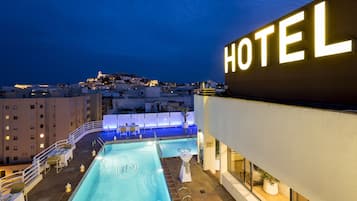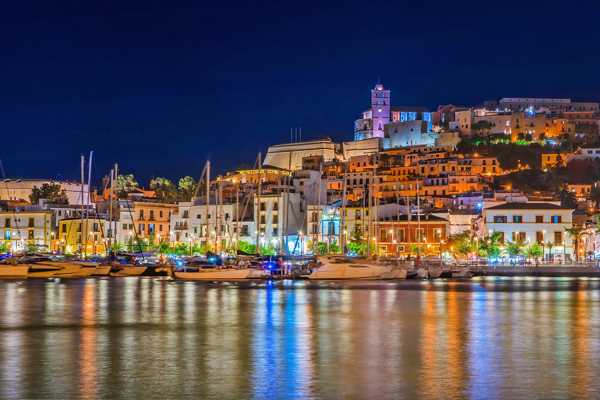Our Ibiza Travel Essentials lays out the essential information you need to help planning your trip to one of the most popular destinations in Spain. No matter how frequently you travel, some questions will always need answers: What’s the weather like? How can I get from the airport to my hotel? What currency and type of plug do I need? We have all these answers plus other basic info about the best time to go, getting there, getting around, and a few useful travel tips.
It’s all compiled in this Ibiza Travel Essentials. After reading this short and easy-to-read guide, you will be a little more prepared to start your trip to Ibiza.
What are the main towns and villages in Ibiza?

Ibiza is the 3rd largest Balearic Island, about 90 km off the Spanish mainland. The 570-sq-km rocky island has a hot semi-arid climate. Today, Ibiza’s worldwide famous for its hectic nightlife and party vibes. Even so, it’s also a UNESCO World Heritage Site filled with historical landmarks such as the Renaissance walls of the old town of Ibiza Town and the remains of the first Phoenician settlement at Sa Caleta. Nightlife, historic buildings, beaches and Spanish coolness make Ibiza an extremely popular holiday destination.
Ibiza Town
Ibiza Town is the island’s buzzing capital, famous for its eclectic nightlife, charming old quarter, and exquisite bars and restaurants. It’s located on the southeast coast of the island and has a population of almost 50,000. Ibiza Town is divided into 2 parts: the Dalt Vila (Upper Town) or the old town and the modern part known as the Eixample.
Santa Eulalia del Río
Santa Eulalia del Río is a laidback resort area known for its top-quality restaurants, gentle pace, and family-friendly atmosphere. Situated around 20 km from Ibiza’s airport, the relatively quiet beachside development has long been a favourite of holidaymakers looking to indulge in a dose of rest and relaxation. The palm-lined promenade, which fronts a wide sandy beach and clear waters, is popular with sun-seekers.
Playa d'en Bossa
Playa d’en Bossa is a wide, sandy beach surrounded by all imaginable entertainment features and amenities. It’s also Ibiza’s longest beach, with plenty of bars, restaurants, and hotels lining its 3-km shoreline. The northern stretch is packed with bustling party spots and pounding dance music, while the southern end tends to be more relaxed and family-oriented.
Sant Antoni de Portmany
Sant Antoni de Portmany is a lively resort area famed for its high-octane nightlife and glorious sunsets. Bursting into life as day turns into night, it boasts some of Ibiza’s most celebrated bars and clubs, with Es Paradis, Eden, and Ibiza Rocks all situated in the area’s famous West End. The picturesque bay is packed with water sports and beachfront amenities.
When is the best time to travel to Ibiza?

- Ibiza has a Mediterranean climate with warm winters and very hot and dry summers.
- Average temperatures range from 12ºC in winter to 27ºC in summer.
- The rainiest months of the year are from October to February, with an average of 5–6 rainy days per month.
- Ibiza is warm and agreeable all year round, but the best times to visit are around May–June and September–October.
- July and August are the best months to go to Ibiza if you want to party.
อย่าลืมแวะอ่าน
- 8 Mistakes People Make When Visiting Ibiza

8 Mistakes People Make When Visiting Ibiza
Spain - 10 Most Instagrammable Places in Ibiza

10 Most Instagrammable Places in Ibiza
Spain - 10 Best Towns and Resorts in Ibiza

10 Best Towns and Resorts in Ibiza
Spain
Ibiza basics

- Primary languages: Spanish
- Plug types: C and F
- Electricity: 230 V
- Currency: Euro (€)
- International dialling code: +34 971
- Emergency telephone number: 112
How to get to my hotel in Ibiza?

Ibiza Airport
Also known as Aeroport d’Eivissa in Catalan, Ibiza International Airport serves the Balearic Islands of Ibiza and Formentera. It sits towards the southern tip of Ibiza Island, 6 km southwest of the town centre. It’s seasonally served from most major cities in Europe and yearly served from the largest cities in Spain and Portugal, including Madrid, Lisbon and Barcelona.
A handful of dining and shopping options as well as information and banking services are in the terminal. There are several transfer options to reach Ibiza Town:
- A taxi to the city centre takes around 15 minutes. The taxi rank can be found just outside the arrivals hall. Note that there are often long queues at the taxi rank in summer.
- The bus line L10 takes around 20 minutes. The bus stop is outside the arrivals area. You can buy the ticket directly on the bus.
- Car rental agencies can be found in the arrivals hall.
Ibiza ferry ports
You can get to Ibiza by ferry from Barcelona, Denia, Palma de Mallorca and Valencia. The ferry terminals are just north of Ibiza Town. From here, transfer options to your hotel include bus, taxi and cars for hire.
How to get around Ibiza?
Travel tips

The most pleasant way to explore Ibiza Town is on foot. There’s a good range of historical landmarks as well as a lively scene of bars, restaurants and shops in the town centre.
For longer journeys from Ibiza Town to beaches, San Antonio and Santa Eulalia, buses, boats, taxis, mopeds and cars for hire are available.
- Travelling by bus is the cheapest option in Ibiza.
- Mopeds (scooters) are available.
- From Ibiza Town, you can reach many beaches on Ibiza and Formentera Islands by Aquabus Ferry Boats. Prices are affordable and cruising around the island is very pleasant.
- Hiring a car is also a good yet more expensive option to discover the island. The price per day depends on the type of car (we recommend open-top jeeps).
Taking a taxi

- Taxi ranks can be found at the airport, ferry terminals and in all towns and resorts. Taxis can also be hailed down on the street.
- Rates are slightly higher at night and on weekends.
- If you do not speak Spanish, a good way to tell the taxi driver where you want to go is by showing him a piece of paper or your smartphone, with the address of your destination written on it.
- As usual, when travelling abroad, beware of taxi scams and double-check that the meter is on.
What are the main annual events in Ibiza?

Ibiza Carnival
- What: Carnival is one of the most anticipated events on the island. It celebrates life with delicious food, fun games, and people in colourful costumes dancing through the streets.
- When: February
- Where: Ibiza Town and harbour
Ibiza International Film Festival
- What: Ibiza International Film Festival focuses on independent films. Film screenings include documentaries, animations, experimental films and more.
- When: May
- Where: Can Ventosa, Cas Serres and Can Jeroni
Ibiza Medieval Fair
- What: Step back in time to the days of the Phoenicians, Romans, Arabs, and Christians who lived in Ibiza in the past few thousand years. This festival showcases them through re-enactments, art shows, and performances.
- When: May
- Where: Dalt Vila
บทความนี้ประกอบด้วยความคิดเห็นของทีมบรรณาธิการ Go Guides Hotels.com จ่ายค่าตอบแทนให้ผู้เขียนบทความลงบนเว็บไซต์นี้ ค่าตอบแทนดังกล่าวอาจรวมถึงค่าใช้จ่ายด้านการเดินทางและอื่นๆ
เริ่มต้นวางแผนการเดินทาง
พักที่ไหนดีใน Ibiza Island

เดอะสแตนดาร์ด, อิบิซ่า

Hotel THB Los Molinos - Adults Only

Hotel Royal Plaza

Hotel Puchet
เรื่องอื่นที่น่าสนใจ
- 8 Mistakes People Make When Visiting Ibiza

8 Mistakes People Make When Visiting Ibiza
Spain - 10 Most Instagrammable Places in Ibiza

10 Most Instagrammable Places in Ibiza
Spain - 10 Best Towns and Resorts in Ibiza

10 Best Towns and Resorts in Ibiza
Spain - Playa d'en Bossa in Ibiza

Playa d'en Bossa in Ibiza
Spain - 10 Best Things to Do After Dinner in Ibiza

10 Best Things to Do After Dinner in Ibiza
Spain - 10 Things to Do Off the Beaten Track in Ibiza

10 Things to Do Off the Beaten Track in Ibiza
Spain - Mirador de Es Vedrá in Ibiza

Mirador de Es Vedrá in Ibiza
Spain - 10 Best Rooftop Bars in Ibiza

10 Best Rooftop Bars in Ibiza
Spain
